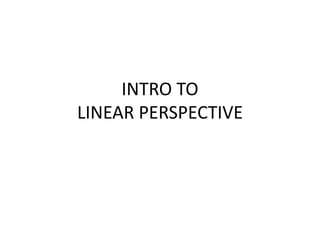
Intro to Perspective
- 2. PICTURE PLANE: An imaginary vertical, transparent plane, like a window pane, Which is always parallel to the plane of the artist’s eyes or viewpoint.
- 3. LINEAR PERSPECTIVE – System of spatial alignment which creates an Illusion of depth on a 2D flat surface. It captures the optical effects of receding objects by organizing Space and depth from a vanishing point of view.
- 5. Study and consider what you're looking at. Is this the best viewpoint to find the best composition? Where are you physically in relation to the scene you are considering painting? Are you elevated, looking downward at your subject? Are you looking up? Standing, sitting, or kneeling? Flying? Once you know where you are find the horizon. What's your Viewpoint? This is the basic positioning of your eyes, just like pointing a camera. What's the best Line of sight, the straight line between you, the Observer, and the Object or focal point of the scene before you?
- 6. See where the sky meets the land? That's the horizon line. It's on the horizon. If objects are blocking your view of the horizon line, turn around until you can determine where it is in relation to your line of sight and extend that knowledge into your chosen view. REMEMBER: The horizon line is always at the eye level of the artist, sitting, standing, flying… It can be high, low or the middle of YOUR work surface.
- 7. Since the farthest we can see here is to the earth's horizon that's where most vanishing points live. Perspective lines start at the vanishing point. The vanishing point is a point in the far distance at which your eyes can no longer see.
- 8. SOME GUIDELINES TO REMEMBER USING PERSPECTIVE: (when all objects are “squared up” to horizon line!)
- 9. The front plane of the object is directly in front of you, verticals parallel, and all lines of perspective meet at a single vanishing point on the horizon.
- 10. When an object or viewpoint is rotated and two sides of an object are angled away from your view, each side of the object has it's own unique lines of perspective.
- 11. If your point of observation is higher or lower a third vanishing point comes into use. This is often called Bird’s Eye or Worm’s Eye View
- 12. By layering visual elements one on top of another, perspective can be implied by the front to back ordering of the elements. Two dimensional art is traditionally viewed according to the conventions of stacking or layering visual elements from the bottom up as foreground, mid- ground, and background. Things look big when they are closer to the viewer, small when they are far away. If you place an object in your drawing it must relate in size to other elements in the drawing. The closer it is, the more detail is visible. Relative Size of Elements Layers and Values
- 13. Aerial Perspective (Atmospheric/Environmental) Leonardo da Vinci was the first to record his thoughts and theories concerning Aerial (Atmospheric) Perspective, or the Perspective of Disappearance. Artists of his time were concerned with realism in their art. Linear perspective was a big step, but with careful observation it became apparent that other natural phenomenon were at work altering the look of distant objects. Leonardo da Vinci's Aerial Perspective Leonardo, The Virgin of the Rocks (detail), 1491-1508 Photo © The National Gallery, London "Perspective is the rein and rudder of painting" —Leonardo da Vinci Moisture and dust in the atmosphere are not that apparent when viewing things close by. As you look at objects further away from you, you are also looking through a thicker mass of air. The moisture and dust building up over distance scatter the light and lighten the appearance of objects, lessening the contrasts of light and shadow and blurring details. Environmental factors like fog, steam, smoke, water mist, or pollution intensify local Aerial Perspective effects.
- 14. When working in color, the distant shapes also take on a bluish cast as their true color intensity is lessened visually. This bluing effect is the more local version of what makes the sky blue. Air molecules (like oxygen and nitrogen) are very small and selectively scatter the shorter (smaller) waves of the visible light spectrum, violet and blue. When you look up during a clear sunny day, the cumulative effect of all this selective light bouncing around gives us our blue sky. Over shorter distances this scattering of short wave light tints distant vistas as you look closer to the horizon. ……“ISH” or “ER” …..Often a Painter will refer to color as “redder” or “reddish”…. ART IS A LIFELONG STUDY AND UNDERSTANDING OF THE VISUAL WORLD AND ALL IT HOLDS. COLOR, LIGHT, EDGES, VALUES, COMPOSITION, PERSPECTIVE ARE ALL INCLUSIVE TO THE SCIENTIFIC EXPLORATION OF OUR INTERACTION AND THE INTERACTIONS WITHIN OUR ENVIRONMENT.
- 15. There’s a lot more to Perspective then the basics…
- 21. WEB RESOURCE AND IMAGES FROM GOOGLE & http://www.watercolorpainting.com/ If you wish to advance your perspective: http://userwww.sfsu.edu/trogu/420/reference/pers pective/
